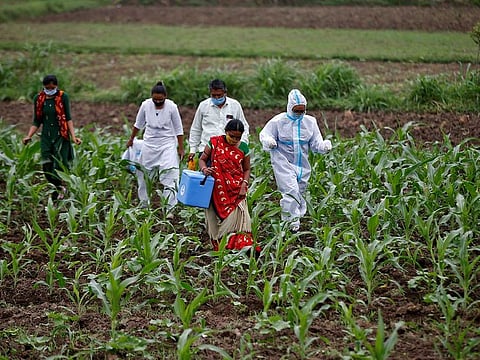COVID-19 vaccination: A billion doses later, India cannot afford to let its guard down
Celebrations over crossing 1 billion doses should not blunt vigilance against lethal virus

On Oct. 21, India crossed an important milestone in its fight against COVID-19 by surpassing the magical mark of 1 billion vaccinations. The country is justifiably proud. The day after, on Oct. 22, Prime Minister Narendra Modi himself appeared on national television to address the people.
He gave credit for this achievement to “Indian science, enterprise and the collective spirit of (1.3 billion) Indians.” He also exhorted his countrymen and women to buy and patronise made in India products as the best way to counter the economic downturn caused by the pandemic.
Modi hailed health care workers that day, and, later, on Saturday, Oct. 23, invited the top pharma manufacturers, to his residence on Lok Kalyan Marg (People’s Welfare Road). Offering them his thanks and encouragement, he emphasised the need to institutionalise best practices so that Indian health care could rise to global standards.
The pharma tycoons in turn praised the Modi administration for the unprecedented collaboration and cooperation between government and industry. Never before, they said, were procedures thus simplified and fast-tracked, nor regulatory reforms and approvals so timely and forthcoming.
Prominent among those who attended were Cyrus and Adar Poonawalla of Serum Institute of India (SII), Krishna and Suchitra Ella of Bharat Biotech International, Pankaj and Shervil Patel, of Zydus Cadila, Mahima Datla and Narender Mantela of Biological E Ltd, Sanjay Singh and Satish Ramanlal Mehta of Gennova Biopharmaceuticals Ltd, Satish Reddy and Deepak Sapra of Dr Reddy’s Lab, and Rajesh and Harshit Jain of Panacea Biotec Ltd.
Again, in keeping with Modi’s personal touch, no single individual, but two members of each company were invited, whether these were father and son, husband and wife, siblings, or senior colleagues.
The Poonawalas’ SII contributed 90% of the billion vaccine doses. They produced India’s leading vaccine, COVISHIELD, in collaboration with AstraZeneca, UK. By tripling their capacity, SII can now manufacture over 200 million doses a month.
The indigenous Covaxin, which accounted for 10% of the shots, is made by Krishna Ella led Bharat Biotech International, with crucial help and inputs from the government funded Indian Council of Medical Research (ICMR) and Council of Scientific and Industrial Research (CSIR).
Global applause
World Health Organisation (WHO) applauded India’s vaccination landmark. Poonam Khetrapal Singh, regional director WHO South-East Asia, said, “India’s progress must be viewed in the context of the country’s commendable commitment and efforts to ensure that these life-saving vaccines are accessible globally.” Congratulations also came from United Nations International Children’s Emergency Fund (UNICEF).
WHO, which relies heavily on India’s cheaper vaccines for its supply to the poorer countries, requested a resumption of its contribution to the worldwide COVAX effort. Unfortunately, the same body, is yet to approve Covaxin for emergency use. This has caused tremendous difficulties for out-of-India travellers who opt for the India-developed vaccine.
Earlier, spats erupted between India and UK over the latter’s refusal to recognise COVISHIELD, though it was practically the same as its own AstraZeneca. The only apparent difference was that the former was made in India. Such glitches highlight problems of economic competition and politics of validation over even life-saving COVID-19 vaccines.
Despite its justifiable euphoria over a billion vaccinations, India’s achievement must be placed in a broader international context to get a more accurate picture of the challenge that still lies ahead. According to reliable data, only 22% of the population is fully vaccinated, that is, has received two doses.
Compare this with the UAE where above 90% of the residents are fully protected. Or with China, where over 75% of the country is wholly vaccinated, with a total of over 2.24 billion doses, or over twice that of India.
India is still a relatively poor country, heavily reliant on imports for both ingredients and know-how as far as its pharma sector is concerned. The dynamism of the people and the positive commitment of its leadership notwithstanding, the road ahead is not as smooth or without unexpected threats as some imagine.
Several of those who have received one dose show no interest in getting the second one. This has not been attributed to vaccine hesitancy as much as to the loss of fear of the virus.
The horror of nearly half a million deaths seems to be a bygone nightmare as people go about without masks and congregate during festivals without social distancing. Even highly disciplined and well-regulated smaller countries such as Singapore have been reporting a sudden spurt of cases, with daily deaths in double digits.
Danger of breakthrough strains
The WHO has warned that the pandemic may extend into 2022. Several parts of the world are lagging behind as far as vaccinations are concerned. In Africa, for example, only 5% are fully vaccinated. There is also the danger of breakthrough strains and new variations of the virus reinfecting those already recovered or vaccinated.
We do not have a clear idea of how long immunity from vaccinations will last. There is also the question of whether children below 12 should be vaccinated and how soon booster shots should be given to the already immunised.
Those who have suffered from COVID-19 swear that it is nothing like the flu. We don’t really need their warnings given that most of us in India have friends and relatives who have died during the pandemic or have returned literally from the edge of death.
India cannot afford to be complacent at this crucial juncture. Every possible effort must be taken to prevent a third wave of the pandemic. The celebrations over crossing the 1 billion doses mark should not blunt the country’s vigilance against the tiny but lethal virus.
Sign up for the Daily Briefing
Get the latest news and updates straight to your inbox








